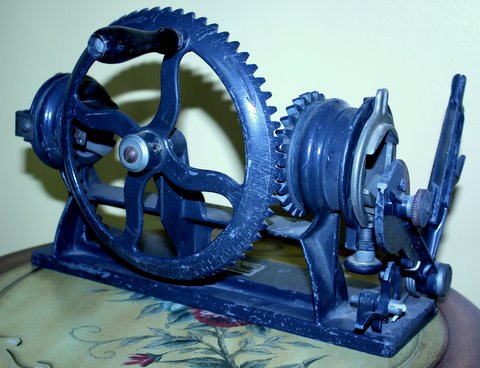I have written about my youth working for my parents and grandparents store cutting spring roller shades. I learned this skill of trimming shades down to size on the Grand Concourse in the Bronx. This was a busy store and part of the job of cutting these in-stock roller shades was doing the task in front of the customer.
The tools we used to cut these vinyl and cloth shades were a pair of scissors to trim and the Star Window Shade Machine for the main cutting. It functioned very simply by inserting the roller shade (with the wood slat removed from the bottom) into the machine, tightening the clamp, spinning the crank by hand and slowly pushing the blade through the material. Here is a photo of that machine which I still have. Next to it is the electric model still used today.


Recently I came across a website from photographer named Jakob Ehrensvärd. He photographs old abadoned sites. I thought his discovery was interesting.
Enjoy:
When travelling around in the search for abandoned sites, odd things are sometimes found – sites or stuff that really seems to hold a story. This is really what makes all of this so fascinating.
Take this factory making roller shades – a guess is that it must have been abandoned for at least forty years. There is of course a story behind the invention of the roller shade, but I don’t know it or how the industry has evolved over the years. I have read a bit about the zipper, which I guess is a child of about the same age.
Let’s do some guesswork here (I may be completely wrong, I give it a try anyway):
Roller shades have a long history (an obvious thing someone may think), but in the early 1900s, someone discovered that you could make them automatic (as we know them of today) by replacing a wire that was used to rise and lower the shade with a spring. In the early days, they were expensive and not very reliable and were therefore a product exclusively for the chic. In 1928, a lonely inventor found out a new spring and locking mechanism and a method to manufacture them in a more automated manner. Prices went down and reliability went up. In the late 1930s, the sales soared as they spread to the general public. A large number of small woodwork- and mechanical workshops entered the lucrative roller shade business, in a business which was hit hard by the 1930s recession. Relatively small investments were needed, which made it attractive for cash-strained smaller workshops like this one.
However, in the mid 1950s, a number of large manufactures entered the scene on a massive scale featuring a high level of automation, leading to drastic price cuts. Competition went stiffer and the first casualties were seen in the late 1950s. This factory was very small and was driven by a man and his wife together with some part-timers. When he was sitting with his wife (I found a pair of woman’s shoes adjacent to a male one) and read the “Swedish car traveller’s holiday guide of 1960” (which I found on a table in the workshop), he must have understood that the workshop would not open again after they returned from their holliday in the summer of 1961. Reflecting over the last year’s financial losses and the inevitable thought that some investments in 1954 when the profits peaked might have changed the game. Why did he reject the trade-sale offer in 1956? Why, why, why… After the inevitable bankrupcy in february 1962, he became a broken and bitter man.
Interesting story. I attached a few photgraphs from that abadoned factory below of items that you may recognize. It reminds me of the function plus form message I keep talking about in my presentations.






